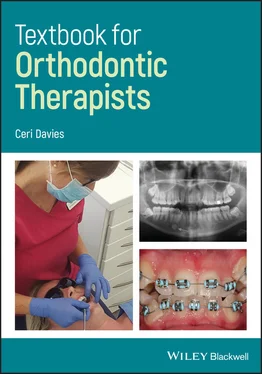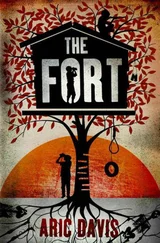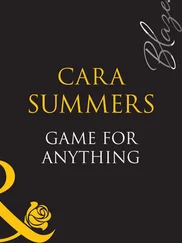31 28 Fixed Appliances28.1 Definition 28.2 Indications for Fixed Appliances 28.3 Advantages and Disadvantages 28.4 Tooth Movement Achieved with Fixed Appliances 28.5 Mode of Action 28.6 Components of Fixed Appliances
32 29 Headgear29.1 Definition 29.2 Extra‐Oral Anchorage 29.3 Extra‐Oral Traction 29.4 Biomechanics of Headgear 29.5 Types of Headgear 29.6 Components of Headgear 29.7 Headgear Injuries and Preventative Measures 29.8 Reverse Headgear 29.9 Assessment of Wear 29.10 Measuring Force
33 30 Instructions for all Appliances30.1 Removable Appliances 30.2 Functional Appliances 30.3 Fixed Appliances 30.4 Cleaning Instructions for the Patient 30.5 Headgear 30.6 Retainers 30.7 Bonded Retainers
34 31 Uncommon Removable Appliances31.1 Nudger Appliance 31.2 En Masse Appliance 31.3 ACCO Appliance 31.4 ELSAA
35 32 Anchorage 32.1 Intra‐oral Anchorage 32.2 Extra‐Oral Anchorage 32.3 What Does Anchorage Depend On? 32.4 Reinforcing Anchorage 32.5 Sources of Anchorage 32.6 Anchorage Loss
36 33 Index of Orthodontic Treatment Need (IOTN) 33.1 Dental Health Component 33.2 Aesthetic Component
37 34 Peer Assessment Rating (PAR) 34.1 Components of PAR 34.2 Assessment of Improvement in PAR 34.3 Who Uses PAR?
38 35 Space Analysis 35.1 Crowding 35.2 Incisor Antero‐posterior Change 35.3 Levelling Occlusal Curves 35.4 Arch Expansion 35.5 Creating Space
39 36 Cleft Lip and Palate 36.1 Prevalence of Cleft Lip With or Without Cleft Palate 36.2 Prevalence of Isolated Cleft Palate 36.3 Syndromes Associated with Isolated Cleft Palate 36.4 Aetiology 36.5 Development of CLP 36.6 Classifications of CLP 36.7 Clinical Problems in CLP 36.8 CLP Team 36.9 Management of CLP 36.10 Orthodontic Implications of CLP
40 37 Orthognathic Surgery37.1 Definitions 37.2 Indications for Treatment 37.3 Radiographs 37.4 Surgical Procedures 37.5 Sequence of Treatment 37.6 Risks and Benefits
41 38 Retention and Stability38.1 Definitions 38.2 Aetiology of Relapse 38.3 How Common Is Relapse? 38.4 Informed Consent for Retention 38.5 Retainers 38.6 Removable Retainers 38.7 Fixed Retainers 38.8 Care of Removable and Fixed Retainers 38.9 Enhancing Stability 38.10 Types of Tooth Movement to Be Retained 38.11 General Advice on Retention 38.12 Five Key Points 38.13 Outcome and Follow‐Up After Debonding
42 39 Interceptive Treatment39.1 Definition 39.2 Clinical Interceptive Situations: Early Mixed Dentition 39.3 Clinical Situations: Late Mixed Dentition 39.4 Clinical Situations: Early Permanent Dentition 39.5 Serial Extractions
43 40 Adult Orthodontics 40.1 Reasons for Adult Orthodontics 40.2 Differences in Treating Adult Patients 40.3 Aesthetic Appliances
44 41 Orthodontic Materials 41.1 Etch 41.2 Adhesives 41.3 Bonding onto Fillings, Crowns, and Veneers
45 42 Archwire Ligation42.1 Definition of Archwire Ligation 42.2 Properties of an Ideal Ligation System 42.3 Methods of Ligation
46 43 Risks and Benefits of Orthodontic Treatment43.1 Risks of Orthodontic Treatment 43.2 Benefits of Orthodontic Treatment
47 44 Oral Hygiene 44.1 Oral Hygiene: Pre‐treatment 44.2 Clinical Features for Good and Bad Oral Hygiene 44.3 Procedure with Patients Presenting with Bad Oral Hygiene 44.4 Procedure with Patients Who Have Improvement in Oral Hygiene 44.5 Oral Hygiene Advice Given at the Fit Appointment 44.6 Preventing Decalcification 44.7 Oral Hygiene Instructions for Appliances
48 45 Decalcification 45.1 Causes of Decalcification 45.2 Occurrence of Decalcification 45.3 Preventing Decalcification 45.4 Treating Decalcification
49 46 Fluorosis 46.1 How Can Fluorosis Occur? 46.2 Products That Can Cause Fluorosis 46.3 Treating Fluorosis 46.4 Preventing Fluorosis
50 47 Fluoride 47.1 Effects of Fluoride 47.2 Toothpaste Ingredients 47.3 Dental Products 47.4 Fluoride Application 47.5 Risks of Fluoride 47.6 Other Causes and Conditions Which Can Affect Enamel Development
51 48 Hypoplastic Enamel 48.1 Aetiology of Enamel Hypoplasia
52 49 Hyperplastic Enamel 49.1 Aetiology of Enamel Hyperplasia
53 50 General Dental Council (GDC) 50.1 Roles of the GDC 50.2 GDC Principles 50.3 Continuing Professional Development 50.4 GDC Register 50.5 Professional Conduct Committee 50.6 Scope of Practice 50.7 Equality and Diversity
54 51 Sharps Injury 51.1 Measures to Take Following a Sharps Injury 51.2 Investigation of Donor and Recipient
55 52 Health and Safety 52.1 Employer's Duty 52.2 Employee's Duty 52.3 Policies Within the Dental Practice 52.4 Clinical Environment
56 53 Control of Substances Hazardous to Health (COSHH)
57 54 Reporting of Injuries, Diseases and Dangerous Occurrences (RIDDOR)
58 55 Consent 55.1 Types of Consent 55.2 Why Do We Obtain Consent? 55.3 When Do We Obtain Consent? 55.4 Who Can Give Consent? 55.5 How Can Consent Be Obtained?
59 56 Pain and Anxiety Control 56.1 Pain Control 56.2 Anxiety Control
60 57 Emergency Care 57.1 Clinical Problems
61 58 Orthodontic Instruments58.1 Adams Spring‐Forming Pliers 58.2 Adams Universal Pliers 58.3 Weingart Pliers 58.4 Bird Beak Pliers 58.5 Distal End Cutters 58.6 Ligature Cutter 58.7 Posterior Band‐Removing Pliers 58.8 Band Pusher 58.9 Band Seater 58.10 Reverse‐Action Bonding Tweezers 58.11 Torquing Turret 58.12 Bracket‐Removing Pliers 58.13 Nylon Bracket‐Removing Pliers 58.14 Angled Bracket‐Removing Pliers 58.15 Dividers 58.16 Boon Gauge 58.17 Micro Etcher 58.18 Flat Plastic 58.19 Tweed Loop‐Forming Pliers 58.20 Mosquitoes 58.21 Mathieu Needle Holders 58.22 Mauns Heavy‐Duty Wire Cutters 58.23 Mitchell's Trimmer 58.24 Separating Pliers 58.25 Cheek Retractors 58.26 Stainless‐Steel Ruler 58.27 Triple‐Beak Pliers 58.28 Tweeds Straight (Torquing) Pliers 58.29 Tucker 58.30 Photographic Cheek Retractors 58.31 Photo Mirrors 58.32 Slow Handpiece 58.33 Debond Burs 58.34 Moore's Mandrel 58.35 Acrylic Bur
62 59 Medical Emergencies 59.1 Common Medical Emergencies in the Dental Practice 59.2 Choking Patients 59.3 Cardiac Arrest Patients
63 60 Eruption Dates 60.1 Deciduous Teeth
64 61 Extraction Patterns 61.1 Class I Cases 61.2 Class II Cases 61.3 Class III Cases 61.4 Balancing and Compensating Extractions
65 62 Tooth Fusion and Gemination 62.1 Treatment
66 63 Extra Notes
67 64 Definitions
68 Index
69 End User License Agreement
1 Chapter 21Table 21.1 Histology of a light force.Table 21.2 Histology of an excessive force.
2 Chapter 25Table 25.1 Cephalometric average values for Caucasians (Eastman standard). Fo...
3 Chapter 34Table 34.1 Weighting factors of each component.
4 Chapter 35Table 35.1 Space required to level the occlusal curve.
5 Chapter 39Table 39.1 Clinical situations for interceptive treatment.Table 39.2 Procedure for serial extractions.
6 Chapter 59Table 59.1 DRS ABCDETable 59.2 Most common medical emergencies.
7 Chapter 60Table 60.1 Eruption and calcification dates for deciduous teeth.Table 60.2 Eruption and calcification dates for permanent teeth.
1 Chapter 1 Figure 1.1 Standard edgewise bracket. The same bracket is used for every too... Figure 1.2 First‐, second‐, and third‐order bends. Figure 1.3 A Begg appliance. The components of the bracket are labelled. Figure 1.4 How the Begg appliance works. (a) The teeth are tipped into the d... Figure 1.5 Preadjusted edgewise brackets. Figure 1.6 Self‐ligating appliance. Figure 1.7 Typhodont showing Harmony lingual appliance.
2 Chapter 2 Figure 2.1 Skeletal class I. Figure 2.2 Skeletal class II. Figure 2.3 Skeletal class III. Figure 2.4 Vertical plane measurements: frontal view. Figure 2.5 Vertical plane measurements: right profile. Figure 2.6 Transverse plane: frontal view looking for any asymmetry. Figure 2.7 Transverse plane: frontal view looking for any asymmetry with a s... Figure 2.8 The different profile patterns.
Читать дальше












